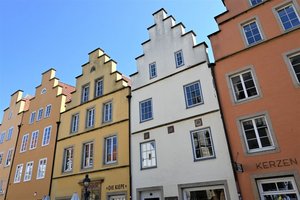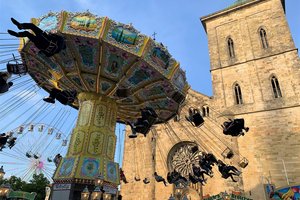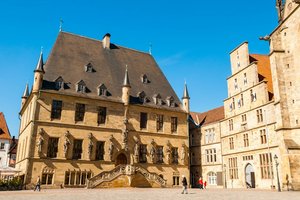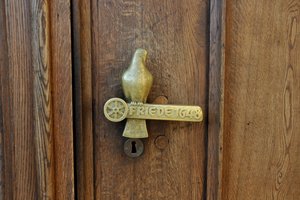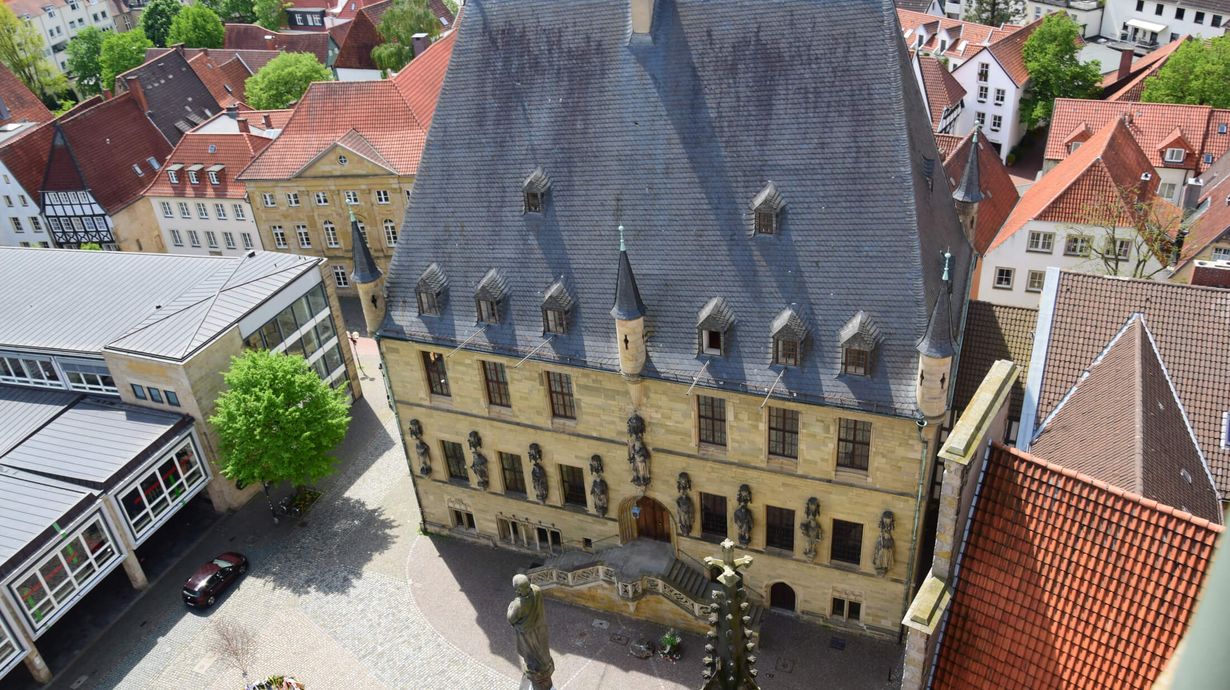The historic Town Hall (Rathaus) of the city of Osnabrück was built between 1487 and 1512 in the late Gothic style, but already shows clear signs of the Renaissance. The front view is dominated by an 18-meter high hipped roof. At its lower end are a total of six towers, reminiscent of the watch and corner towers of a fortress. Since 1846, a large stone staircase has formed the entrance to the Town Hall, after it was previously entered via a retractable wooden staircase. Since 1963, the "Peace" door handle made of heavy bronze by sculptor Fritz Szalinski has been on the 500-year-old entrance door. It shows a dove on a beam with the inscription “Peace 1648” (Friede 1648) as well as the city coat of arms in the form of the Osnabrück wheel. The city's founder, the Frankish king and later emperor Charlemagne, is enthroned above the entrance. At his side since the 19th century are the eight so-called emperor sculptures, a gift from the Prussian royal house to the city of Osnabrück.
The first floor of the Town Hall houses, among other things, the Friedensaal (Chamber of Peace) and the Treasury, where the council silver, coins, mint stamps, the oldest marksmen's chain and important documents are kept. On the upper floor is a model of Osnabrück in 1633 created in the mid-1950s by sculptor Heinrich Bohn.
On September 13, 1944, the Town Hall was badly hit during an Allied bombing raid. The historical furnishings had been moved out some time before and could thus be saved. Reconstruction began as early as 1947 and was completed in time for the 300th anniversary of the Peace of Westphalia on October 25, 1948.
On 5 July 2019, an attack on the historic entrance door took place. However, the damage, which was only superficial, was repaired.
Background to the construction of the Town Hall
As early as 1244, an Osnabrück Town Hall on the Marktplatz (market place) was first mentioned in documents. It was located on the site of today's city library and was demolished in 1836. In the course of the 15th century, its relatively small size was no longer sufficient for the needs of the growing city and the diverse tasks of civic self-government. The decision to build a new building led to a laborious and long process. Preparations began as early as ten years before the start of construction, in 1477. Since there was no central place in the densely built-up city, a new building site had to be created. The cemetery of the Marienkirche (St. Mary's Church) was moved behind the church, houses and a whole alley had to disappear to make way for the site of today's Town Hall and market place. It was not until 1487 that the 25-year construction period of the "New Town Hall in the Old Town” began. Based on former town accounts, the estimated total cost of construction was about 6,000 marks. Converted to today's value, the cost was about 23 million euros. The construction was financed from the current city budget, depending on the cash situation. In 1487 and 1503, the council levied a special tax to finance the construction. The high charges also led to revolts.
The driving force behind the project is believed to be Ertwin Ertman, the mayor of Osnabrück at the time. Coming from a humble background, he had made it to power and influence. He represented Osnabrück at the Hanseatic League in Cologne, Bremen and Lübeck. As early as 1452, he succeeded in ending the exclusion from the Hanseatic League that had been imposed two years earlier for ten years. Despite social unrest, Ertman held the office of mayor of the old city for 23 years and sat on the council for 52 years. He did not leave office until the year of his death in 1505.
With the construction of the new Town Hall, the citizens set a self-confident centre against the religious cathedral immunity. In doing so, they symbolised their independence, economic strength and position of political power.
The Chamber of Peace and the Peace of Westphalia
The Friedensaal (Chamber of Peace) was originally designed as a council chamber, or meeting hall: A room with a revolving bench and a spectacular "democratic" concept: all those present looked each other in the face during deliberations. There was no spatial hierarchy; the Council itself formed the centre of its decisions.
From 1643, the Chamber of Peacel became one of the two venues for the negotiations of the Peace of Westphalia (1648). Along with Münster, the peace treaties ending the Thirty Years' War (1618-1648) were signed here. The walls of the Chamber of Peace are adorned with portraits of the 42 European envoys to the Peace Congress painted by the Flemish painter Anselm van Hulle in 1648 and portraits of the rulers of the warring parties at the time (including Queen Christina of Sweden, Louis XIV of France or the Roman-German Emperor Ferdinand III). Below the portraits and windows is the oak pews decorated with carvings, which combine Gothic patterns with early Renaissance motifs. The so-called privilege shrines - set into the masonry between the windows - served among other things as Wändeschränke (wall cupboards) of the large Osnabrück hospitals for the safekeeping of important documents such as foundation deeds and prescriptions. They have figural and ornamental carvings. The wall cupboards with simpler doors could be rented by citizens as a kind of safe deposit box for their valuables. A wrought-iron chandelier from the 16th century towers over the room as the central showpiece. Its three levels figuratively represent paradise, the firmament (heavens) with sun, moon and stars, as well as Mary with the infant Jesus and three representatives of the estates. The thirty-six point reindeer antlers were added later. Queen Christina of Sweden gave it to the city of Osnabrück for the signing of the peace treaty.
The Peace of Westphalia is considered an outstanding event in German and European history because it laid the first foundations for a united Europe. Since April 2015, Osnabrück Town Hall and Münster Town Hall have therefore been awarded the European Heritage Label. The European Commission awards this seal to places that have a special significance for the history of Europe.
The City Weighing House
The City Weighing House (Stadtwaage) is located directly next to the Town Hall. Today it is home to the registry office, among other things. The building was erected between 1531 and 1532 as a two-storey, gabled building of quarried limestone masonry. The four-stepped gable is a characteristic feature. On the façade of the attic, two bearded men holding the town's coat of arms can be seen. After destruction during the Second World War, the City Weighing House was rebuilt for the city council in 1953.
The building was originally used for weight and quality control of goods (especially textiles). The products were measured, weighed and the duties due were also determined. After thorough inspection, the goods were given a seal in the form of the Osnabrück wagon wheel. In the Middle Ages, herbs were also stored in the attic of the City Weighing House. These later formed the Grut, a spice mixture to make the beer palatable.
At a glance
| Opening times |
The town hall information desk is open Monday to Friday from 10 am to 5 pm.
The historic Osnabrück Town Hall is open for tourist visits from Monday to Friday from 10 am to 5 pm, on Saturdays from 9 am to 4 pm and on Sundays from 10 am to 4 pm. The town hall is not usually open on public holidays. |

